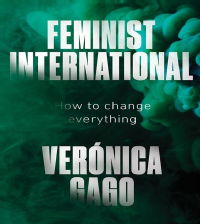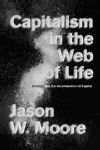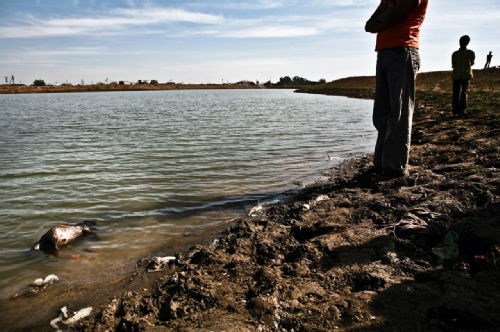All entries for January 2023
January 31, 2023
Territorial Bodies in Context
Writing about web page https://warwick.ac.uk/fac/arts/hrc/confs/territorialbodies/
In the following blog post, organisers Maddie Sinclair and Charlotte Spear reflect on the inspiration behind their upcoming conference Territorial Bodies: World Culture in Crisis.
Taking place on 25th February 2023, Territorial Bodieswill critically evaluate the interconnections between bodies, territories and violence in contemporary world culture. The conference takes inspiration from the Latin American feminist transnational concept of body-territory, which has been used as a ‘strategic’ tool to engender new forms of global solidarity, linking multi-form violence at various scales (Gago, 2020: 95). As Veronica Gago discusses, the transversal concept of body-territory draws on the collective knowledge of indigenous women on the front lines of resistance against neo-extractivism (fracking, mining, agri-business). In such feminist imaginaries, the renewed conceptualisation of the ‘body-as-battlefield’ underlines the ‘organic connection’ between accumulation, heteropatriarchal and colonial violence (Gago, 2020: 84). The concept has infused the ‘practical cartography of the strike’ in the twenty-first century, offering a ‘diagnosis’ of intersecting forms of violence unleashed by financialised ‘popular indebtedness’ and neo-extractivism targeting ‘common resources’ in indigenous territories (Gago, 2020: 11). Gago describes the strategic ‘idea force’ of the body-territory as it intersects with the extractive operations of capital:
 ‘The notion ties together a perspective that explains how the exploitation of territories is structured in a neo-extractive mode today, and how that also reconfigures labor exploitation, mapping the ways the dispossession of the commons affects everyday life. That is why it is strategic in a very precise sense: it expands our way of seeing, based on bodies experienced as territories and territories experienced as bodies. That image of the body-territory reveals the battles that are occurring here and now, pointing to a field of forces that it makes visible and legible on the basis of conflicts. The body-territory is a practical concept that demonstrates how the exploitation of common, community (be it urban, suburban, peasant, or Indigenous) territories involves the violation of the body of each person, as well as the collective body, through dispossession’ (Gago, 2020: 86).
‘The notion ties together a perspective that explains how the exploitation of territories is structured in a neo-extractive mode today, and how that also reconfigures labor exploitation, mapping the ways the dispossession of the commons affects everyday life. That is why it is strategic in a very precise sense: it expands our way of seeing, based on bodies experienced as territories and territories experienced as bodies. That image of the body-territory reveals the battles that are occurring here and now, pointing to a field of forces that it makes visible and legible on the basis of conflicts. The body-territory is a practical concept that demonstrates how the exploitation of common, community (be it urban, suburban, peasant, or Indigenous) territories involves the violation of the body of each person, as well as the collective body, through dispossession’ (Gago, 2020: 86).
Territorial Bodies situates this renewed conceptualisation of ‘body-territory’ within a wider nexus of materialist thinking on the human body as a site of crisis. As Jason Moore writes in Capitalism in the Web of Life:
' The transition from capitalism and nature to capitalism-in-nature asks us to place human bodies as sites of environmental history, as bodies engaged in producing "real" commodities and reproducing the "false" commodity, labor power. From here, we- can reconceptualize capitalism: as a system whose chief contradictions turn on the antagonism and interdependence of commodity-relations and the totality of the conditions of reproduction. The human body, in this frame, becomes a crucial site of the contradictions of world accumulation’ (Moore, 2015: 26).
The transition from capitalism and nature to capitalism-in-nature asks us to place human bodies as sites of environmental history, as bodies engaged in producing "real" commodities and reproducing the "false" commodity, labor power. From here, we- can reconceptualize capitalism: as a system whose chief contradictions turn on the antagonism and interdependence of commodity-relations and the totality of the conditions of reproduction. The human body, in this frame, becomes a crucial site of the contradictions of world accumulation’ (Moore, 2015: 26).
With this in mind, Territorial Bodies considers how the ‘territorial body’ offers a critical framework for addressing what Moore describes as the ‘singular process’ of socio-ecological crisis today (2011: 136). The conference invites critical debate surrounding the strategic “idea force” of the territorial body: bodies experienced as territories, and territories experienced as bodies (Gago, 2020: 86). In particular, the conference will explore how the territorial body “expands our way of seeing”, offering a critical framework for addressing urgent social, ecological and political challenges, from ecological breakdown to the rise of statelessness, violence against women and racial exploitation. Bringing together delegates from across the world, the conference synthesises diverse and interdisciplinary research interests, from aquatic bodies to mining bodies, to embodied extractivisms and narratives of sexualised resistance. We hope to consider how cultural registrations work to locate the body as a distinct part of socio-ecological crisis, bringing new perspectives to bear on the notion of “territorial bodies” as a framework for deciphering ‘crisis’ in the twenty-first century. You can register for the conference here.
January 18, 2023
Veteran Poetics: An Interview with our Keynote Speaker Professor Kate McLoughlin
Writing about web page https://warwick.ac.uk/fac/arts/hrc/confs/homecoming/
In this third blog post for the HRC Conference on Homecoming after war, the co-organiser, Niels Boenderinterviews the keynote speaker, Professor Kate McLoughlin, Fellow at Harris Manchester College Oxford.
Thank you for agreeing to be interviewed, andgiving the keynote at our conference. Let me start by asking about your recent book Veteran Poetics. You draw on a huge and diverse range of texts from modern British literature. Why do you think the figure of the veteran is so salient during this period and in this place?
Literary texts in this period, which begins with the French Revolution, are grappling with the implications of modern, mass, industrialisedwarfare. Those implications called into question many ideas associated with the Enlightenment: that we remain the same person over time, that hospitality is a good thing, that problems can be solved scientifically, that we can learn from experience. Modern war undermined all that and the product of modern war - the veteran - is the obvious and ideal figure through which to explore the situation. Or, more succinctly, veterans tell us what it's like to be modern.
To what extent do you draw on inter-disciplinary approaches for your work? How for instance do literary studies and history co-exist in your work?
In Veteran Poetics, the main other discipline I draw on is philosophy. I'm a specialist in modern literature but I'm also a trans-historicist. That doesn't mean cutting across history but being historically aware in a local way and alsobeing very aware of literaryhistory.
Do you think there is a specific significance to the moment of ‘homecoming’?
The moment of homecoming is what inspired Veteran Poetics: specifically, the moment of homecoming in Wolfgang Borchert's Drauβen vor der Tür(Outside the Door). Reading this German play, which is an instant of post-Second World War Trümmerliteratur(rubble-literature), I was struck by the textual chaos wrought by the veteran who returns home to find he has lost everything. The familiar-turned-stranger, the effect of lost time, the sense of alienation: all these struck me as extraordinarily rich in emotional and conceptual terms.
Especially in light ofyour present work, how do we accommodate the figure of the ‘silent’ veteran? I’m thinking particularly of historians for whom silence is often uncomfortably unassimilable.
I'm still trying to answer that question! The final chapter of Veteran Poetics reads the silent literary veteran as embodying crises in post-Enlightenment communication. I start to suggest in the Conclusion that, rather than trying to get the silent veteran to speak, we might honourtheir silence. This ties in with theories about silence from critics such as Edouard Glissant, Judith Butler, Rita Felskiand Dorothy Hale in the so-called 'post-critique' turn. But I'm still not sure what 'honouringsilence' looks like as actual literary criticism. All I can say is that 'uncomfortable' doesn't necessarily equal 'bad'.
Your most ambitious claim in Veteran Poetics is the way in which the figure of the veteran upsetsstandard narratives of the Enlightenment. Could you just briefly explain this thesis to our readers?
I say a little about this above. It seems to me that there are certain figures - the war veteran is one example, the refugee is another - who stand counter to the flow of narratives about Enlightenment progress. That's not to say that reason hasn't brought immeasurable benefits. But not without cost, and these figures are the human embodiment of the cost.
Your discussion of the Enlightenment made me think especially of how veteransfigure in non-Western contexts. In countrieswhich had liberation struggles for instance, they are of immense importance to national identity. While accepting this is not your area of expertise, do you have any thoughts on what role the figure of the veteran might play outside Britain?
How we understand veterans is very much culturally specific, becauseit's also about how we understand bravery, gender, sexuality, gratitude, service, sacrifice and a host of other things, including God. Not something I'm qualified to comment on further, but I'dbe fascinated to know more about how these elements contribute to the shaping of the veteran figure in non-western contexts.
Thanks very much for those answers, and we look forward to hearing more about your work in May!
January 09, 2023
Disaster and the Territorial Body
Writing about web page https://warwick.ac.uk/fac/arts/hrc/confs/territorialbodies/
In this blog, HRC Doctoral Fellow Charlotte Spear, reflects on how the conference - 'Territorial Bodies: World Culture in Crisis' links to one of the most recent chapters of her own thesis.
In the aftermath of the devastating 1984 Bhopal Gas Tragedy, Raghu Rai takes one of the most famous images to come out of the disaster, “An Aborted Foetus When The Tragedy Struck, 1984” (Rai). Unborn babies are contorted and forced into the space of makeshift test tubes, cruelly taken from the safety of their mothers’ wombs after the release of ‘46.3 tons of methyl isocyanate from the factory run by the Union Carbide corporation, an American transnational with a pesticide-manufacturing facility in Bhopal, India’ (Kovel 28), killing between 5,000-10,000 people instantly and leaving over 500,000 injured (Kovel 28). These children, simultaneously prematurely born and yet fated never to be born, by what we now know to have been an avoidable disaster, are pictured on a wall overlooking a city. They are both within and without, overlooking and overlooked by the cityscape behind.
Rai, like streams of other photographers, writers and activists following the disaster, intimately connects non-human place and the human body in his work. Bhopal becomes the horrific archetype of Naomi Klein’s sacrifice zone; those zones which are abandoned to the toxicity of a contemporary energy regime which is ‘so inherently dirty and toxic that [it requires] sacrificial people and places: people whose lungs and bodies can be sacrificed’(Klein). Whilst we often think of disasters as somehow accidental, sudden, ‘a rupture or inversion of the normal order of things’ (Anderson 1), the Bhopal Tragedy was none of these. Union Carbide ‘had designed the plant in a way that made accidents more or less inevitable’, ‘switched to the use of [methyl isocyanate] in order to produce more cheaply’ and built the plant in an area close to the population of Bhopal in order to save money (Kovel 32).
Not only does the disaster harm the people who breathe in this toxicity, a toxicity which ‘is driven inward, somatized into cellular dramas of mutation that – particularly in the bodies of the poor – remain largely unobserved, undiagnosed, and untreated’ (Nixon 6), but it lingers in the other-than-human nature which absorbs the poisons and houses them even now. Multiple reports over the last few decades have found the soil and water in the area to hold significantly higher than safe levels of a variety of chemicals including mercury, organochlorine compounds (Labunska et al. 3), lead, pesticides, Volatile Organic Compounds and Halo-Organics (Surviving Bhopal 2002: Toxic Present - Toxic Future).

Andy Spyra/Getty Images
“January 24 2007: Local men are standing on the edge of a contaminated water pond which was used for cooling the factory but got completely poisoned after the gas-leak. In the water swims the remains of a dead dog.”
The status of the people and land of Bhopal as somehow sacrificial extends into and directly impacts upon the fight for justice after the disaster. After the case was originally brought to court in the US, Judge Keenan mandated the Bhopal case to the Indian courts on May 12th 1968 under the auspices that ‘the Indian legal system is in a far better position than the American courts to determine the cause of the tragic event and thereby fix liability’(Baxi 68). As Mukherjee argues, ‘this legal defence is in effect a philosophical position that assumes an unbridgeable gap between two apparently discontinuous worlds. What is human in one, is not so in the other’ (Mukherjee 142).
And so, the question becomes, where are universal human rights in all of this? A large American company cuts corners to save costs, and in doing so essentially sacrifices not only the land on which the Union Carbide factory stood, but also the population surrounding it, many of whom lost their lives. As the people of Bhopal attempt to seek justice for this dire abuse of their human rights, their fight for justice is forcibly spatialised; not allowed to exist in the ‘world’ or ‘universal’ human rights, but rather enforced as a distinctly Bhopali issue. In this sense, then, the experience of so-called ‘universal human rights’ appears in fact to be entirely dependent on locationality: the human body as the site of the abuse of human rights becomes not a singular unit but rather entirely relational with the land and geopolitical organisation of that land. The body, in its experience of – and abuse of – human rights, becomes inherently the geopolitically territorial body.
Keywords:
Disaster, territorial, body, rights, Bhopal
Works Cited
Anderson, Mark D. Disaster Writing: The Cultural Politics of Catastrophe in Latin America. University of Virginia Press, 2011.
Baxi, Upendra, editor. ‘Judge Keenan’s Decision’. Inconvenient Forum and Convenient Catastrophe, N.M. Tripathi PVT. LTD., 1986, pp. 35–69.
Klein, Naomi. ‘Let Them Drown: The Violence of Othering in a Warming World’. London Review of Books, vol. 38, no. 11, June 2016, https://www.lrb.co.uk/the-paper/v38/n11/naomi-klein/let-them-drown.
Kovel, Joel. ‘Capital’. The Enemy of Nature: The End of Capitalism or the End of the World?, by Joel Kovel, Zed Books, 2007, pp. 26–50.
Labunska, I., et al. The Bhopal Legacy: Toxic Contaminants at the Former Union Carbide Factory Site, Bhopal, India: 15 Years after the Bhopal Accident. microform, Greenpeace Research Laboratories, Dept. of Biological Sciences, University of Exeter, 1999.
Mukherjee, Upamanyu Pablo. ‘Dead Air: Indra Sinha’. Postcolonial Environments: Nature, Culture and the Contemporary Indian Novel in English, by Upamanyu Pablo Mukherjee, Palgrave Macmillan/Arts & Humanities Research Council, 2010, pp. 134–62.
Nixon, Rob. ‘Introduction’. Slow Violence and the Environmentalism of the Poor, Harvard University Press, 2011, pp. 1–44.
Rai, Raghu. An Aborted Foetus When The Tragedy Struck, 1984. Online, 1984, https://raghuraifoundation.org/bhopal/.
Surviving Bhopal 2002: Toxic Present - Toxic Future. Shrishti, 2002.
 Sue Rae
Sue Rae

 Please wait - comments are loading
Please wait - comments are loading
 Loading…
Loading…